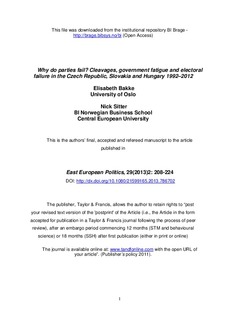Why do parties fail? Cleavages, government fatigue and electoral failure in the Czech Republic, Slovakia and Hungary 1992–2012
Journal article, Peer reviewed
Permanent lenke
http://hdl.handle.net/11250/93768Utgivelsesdato
2013Metadata
Vis full innførselSamlinger
- Scientific articles [2181]
Originalversjon
10.1080/21599165.2013.786702Sammendrag
During the first two decades after the collapse of communism 37 political parties won representation in the Czech, Slovak or Hungarian Parliaments. By 2012, 22 of these parties had failed in the sense that they have fallen below the five-percent electoral threshold at least once. This set of failed parties includes a wide range of parties, from the far right and nationalist flanks to unreconstructed communists, including centre, green, agrarian, Christian and social democrat parties. Some were represented in parliament for one term only, others were in parliament for two decades. In this article we explore how and why these parties fell out of parliament. Beyond the obvious answer – that they failed to win enough votes – five factors involve particularly high political risk for political parties. Two system-level factors are somewhat beyond the control of the smaller parties: changes in the salience of cleavages and the electoral system. However, the other three are directly linked to the parties’ strategies for competition: whether they participate in coalition government as a junior partner, how they manage internal dissent, and the party’s organisational strength.
Beskrivelse
This is the authors’ final, accepted and refereed manuscript to the article
